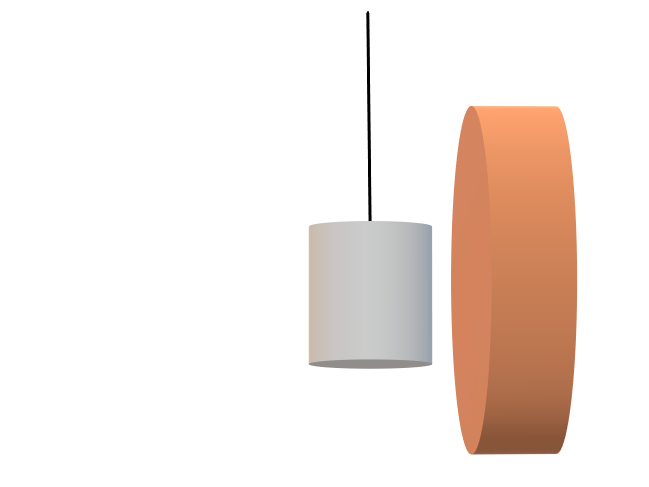A great question! I cannot answer it in full detail, but one thing is certain.
The magnet will levitate over the superconductor's surface.
In the copper and magnet experiment, eddy currents in the copper disk dissipated due to resistance in the copper bulk. This is why the falling magnet is finally falling to the surface: the eddy current's magnetic field dies off as its energy is converted to heat.
The current in the superconductor does not die off, and keeps repelling the approaching magnet, stronger and stronger as it gets closer. At some point, the forces balance off.
Now, the picture is a little bit more complex that this. If you did not allow the falling magnet to rotate (make it fall always its north pole down), then the magnet would simply bounce off to its original height, and then continue bobbing up and down forever. But there is much more intricacy in a realistic experiment:
- The approaching magnet's north pole is closer to the conducting surface, and feels stronger push back from the superconducting magnet (as soon as you started the eddy current, the superconducting piece is just a permanent magnet, assuming the current does not change). This fall is unstable, and a tiny deviation from the vertical will give an angular momentum to the falling magnet.
- Assuming the surface the magnet falls to is not infinite, the magnet will also tend to slide sideways, as repelling magnets normally do if you try to push them together, because field lines won't be parallel to the finite superconducting surface.
- In response, the superconducting magnetic field will adjust to counter any of these magnet movements. For example, both sideways and angular acceleration will receive a counter-push from the changing superconductor current.
- The falling magnet is also a piece of metal, and subject to eddy currents from the magnet it falls onto, as long as its induced field varies. This is the chief source of damping the whole dynamics of the system. (There's of course air resistance, too.)
- And there are two different types of semiconductors, which respond to the changes of external magnetic field differently: the induced field in one is smooth (perfectly smooth in theory), but the other's is rough and bumpy. These are called, somewhat uninventively, Type I and Type II, respectively.
In the experiment (oh, and can you imagine how much did we play with the first samples of high-temp superconducting YBaCuO ceramics we could only lay our grabby experimentalist hands on, when they were discovered in the late 80s!), the magnet tends to slide and escape the superconducting plate if you drop it roughly, but if you place it more carefully, it just stays there. If you push it, it slides but stops. If you give it a bit of rotation, the magnet will rotate, but then slow down and stop, too. It looks almost like it is suspended in a viscous liquid. Our first samples were so small that we only could play with a magnet on a string, which the tiny piece of superconductor promptly repelled. But over a sizable (a few centimeter in diameter), flat plate they were levitating steadily, if placed carefully enough.
This is how a high-temp, "bumpy field" type II superconductor behaves (I recall this is called “flux pinning”, but it's a bad name, IMO). However, I do not know from experience what would exactly happen if you dropped a magnet on a chunk of metallic type I superconductor as large as the experimenter's copper disk, as current (including out case of induced eddy current) in superconducting metals produces a very smooth magnetic field, and expel all magnetic field lines out of material. The high-temp ceramic, in contrast, lets some field lines through what you can think about as perfect quantum "holes" or thin tubes in the material. I think in this case the magnet would experience much less viscous interaction with its induced magnetic field, but would it eventually stabilize, or just end up sliding sideways forever (on until it finds the edge of the superconductor plate and falls, whichever comes first), and whether it will it stabilize rotationally or tumble, I do not know. All the above effects still apply, but I cannot clearly imagine the full dynamics. My best guess is that rotation and up/down bobbing would nearly (exponentially) cease due to induced eddy current losses the magnet, but there is nothing much I can think of to eat up the constant momentum of a magnet flying parallel to the semiconducting surface in the perfectly smooth field. I just do not know how "bumpy" is the field in real, not theoretically perfect superconducting metals.
EDIT: Here's a recorded experiment of this exact setup, with a bulk rare earth magnet levitating over a flat piece of superconducting ceramics: https://youtu.be/qYhnt6Q_dXg?t=205. The link is to the point in the video where the effect can be observed the best. The narration is physically irrelevant, to say the least, but the demonstration itself is very clear. The dark disk at the bottom of the liquid nitrogen bath is a piece of superconducting ceramic, and the shiny cube floating over it is a magnet.
 (higher quality available here) from this video, showing a magnet swinging towards a large disk of copper, where it stops gently before hitting the magnet. I understand that the eddy currents have a braking effect on the magnet. What I am curious about is how this would be affected if the copper disk was to be replaced by a superconductor.
(higher quality available here) from this video, showing a magnet swinging towards a large disk of copper, where it stops gently before hitting the magnet. I understand that the eddy currents have a braking effect on the magnet. What I am curious about is how this would be affected if the copper disk was to be replaced by a superconductor.

